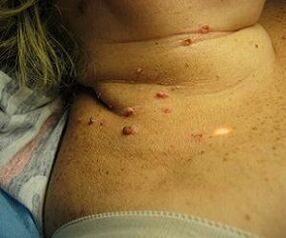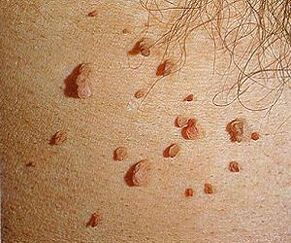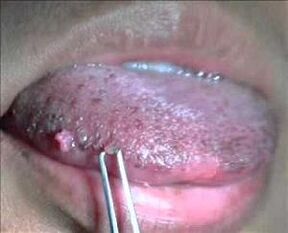
Papilloma virus is a group of viruses, in which there are about 24 subgroups. About 600 species have been discovered to date. It is transmitted only from person to person. Many people and doctors face the problem of diagnosing and treating the human papilloma virus (HPV). The virus is able to stimulate tumor processes, it is found on the skin, in the esophagus, on the mucous membranes of the mouth, in the bronchi, conjunctiva, and even in the rectum.
Causes and ways of infection

Human papilloma virus is a very common disease transmitted by:
- during sexual intercourse;
- when he touches, he kisses;
- through scratches or cuts when visiting the pool, bathroom, public restrooms or gym;
- when shaving or epilating.
Statistics say that women get infected with one partner in 20% of cases.
About 70% of the population is ill and carriers of HPV. The virus is especially actively transmitted from patients who have warts on the body (it is this virus that causes their appearance) in the form of pointed or flat uneven growths on the skin and genitals. In medicine, they are called warts and papillomas.
Possible infection of the newborn by the mother during childbirth. In babies, the disease manifests itself in the form of growths in the throat or genitals.
Symptoms and development of the virus
The latent period of the disease (incubation) can last from two weeks to several years. There are no visible signs of the virus at this time.
The appearance of warts on the skin can appear gradually and one by one, but it is also possible that many warts or papillomas grow quickly at once, similar in shape to sea kale.
If the infection occurred sexually, then the human papilloma virus manifests itself in women:
- in the labia;
- vagina;
- cervix;
For men:
- around the head of the penis;
- on the skin of the genitalia.
When partners are obsessed with oral sex, the mucous membranes of the mouth and throat are affected, for lovers of anal sex - the anus, rectum.
Men rarely suffer from this disease, although they can be carriers of it. When examining a spouse, the virus is more common in women.
Attention!If suspicious growths are found, consult a doctor immediately, because in some types of viruses, neoplasms are reborn, causing cancer.
Classification and types

To date, about 600 types of viruses have been detected. They are generally harmless and disappear within two years after infection with normal immunity.
However, about 40 species are dangerous to humans, causing neoplasms, both benign and oncological.
In the 1980s, doctors proved a link between HPV infection and cervical cancer.
The following types of viruses are classified according to the location of skin lesions and varieties:
- plantar;
- "butcher's nipples";
- ordinary;
- apartment.
On the genitals:
- genital warts;
- flat, cause changes in the surface of the cervical membrane and cause oncology;
- papillomas that cause cancer of the genitals and anus, in both women and men.
Other types:
- damage to the oral mucosa;
- respiratory tract papillomas;
- tumors of the neck, head, lungs.
Varieties:
- Simple papillomas appear on the back of the palms, and in children they can grow on the knees. They look like coarse growths in the shape of cones.
- Plantar - interfere with walking, at first look like shiny growths, and then grow to a nipple with an edge at the bottom. Growing up, they form a whole series of similar formations.
- Flat - the color is slightly different from the skin, but causes itching, redness, discomfort.
- Filiform. In medicine they are called acrochords. They occur more often in people older than 50 years. At first they look like yellowish bumps, they grow, forming growths up to 6 mm.
When warts appear in visible places, a sick person can go to a medical facility for diagnosis and treatment. It is more difficult to determine the defeat of the cervix or vagina, especially if women neglect to visit a gynecologist.
Viral diagnosis
If suspicious growths in the form of papillary (warts) or uneven, bumpy warts appear on the skin or mucous membranes, be sure to consult a doctor. Warts do not cause cancer as often as flat papillomas, but it is best to remove them to reduce the chance of infecting those around you.
Due to the possibility of developing cancer, such neoplasms are being investigated.
The doctor takes an analysis for the human papilloma virus - scraping from the surface of the mucosa (colposcopy with damage to the cervix - examination of the mucosa under strong magnification) or skin. The sample is examined under a microscope for changes in tissue structure (dysplasia), as well as determining the type of virus.
Cervical swabs were divided into 5 classes according to the results of a cytological study:
- no changes;
- changes are caused by inflammatory processes;
- there are minor changes in cell structure, histology is required;
- found cells with signs of malignant changes;
- there are many cells with signs of cancer.
Histological examination gives a more detailed picture of changes in tissue structure.
Clinics use special HPV tests that allow you to get more accurate test results. A positive test result indicates the appearance of malignant processes in the tissue.
HPV is at high oncogenic risk. High risk of cancer is caused by human papilloma viruses types 16 and 18, which are found in 70% of cases.
Based on the results of the examination, a diagnosis is made and treatment is prescribed.
Methods of treating HPV

How to treat human papilloma virus? In connection with the reduction of immunity caused by the disease, first of all, doctors prescribe drugs that increase it:
- interferons;
- interferonogen.
But the main means of treatment is the obligatory removal of neoplasms by the methods of modern cosmetology:
- diathermoelectrocoagulation;
- cryodestruction ("cauterization" with liquid nitrogen);
- laser removal;
- radio or chemical treatment;
- introduction of immunostimulants or immunomodulators into growths.
In any case of illness, the type of treatment should be determined by a specialist.
If, according to the results of the examination, no pathological processes are found on the skin, only papillomas with a small area of skin around them are removed. If malignant cells are detected, surgery can involve a significant area, depending on the depth of the lesion.
Folk methods and recipes
How to cure human papilloma virus? At all times, traditional medicine has helped fight disease. Experience in treating HPV is also quite extensive.
Remedies recommended by traditional medicine. You can lubricate the nipples:
- celandine juice;
- sour apple juice and their pomace;
- dandelion juice;
- ammonia.
Proven recipes:
- Prepare an infusion of chaga, celandine, hemp, freeze it and apply ice cubes 3-4 times a day.
- Lubricate with castor oil, then cover with a cloth. Usually 5-6 such procedures are enough.
- Kerosene and nuts. Grind unripe walnuts in a meat grinder, then mix: for 1 part nuts - 2 parts kerosene, the mixture should be infused for three weeks. Apply to nipples 2 times a day.
To increase immunity, herbalists recommend a drink
- potato juice
- echinacea infusion,
- rosehip tea.
Herbal collections:
- dandelion root, nettle, lemon balm, horsetail, plantain;
- wormwood, St. John's wort, tricolor violet, dill (seeds), calamus (root), clover (flowers), plantain.
HPV treatment at home
You can remove papillomas at home with the help of medicines sold in pharmacies:
- A special composition that freezes nipples. It must be applied carefully so as not to get on healthy skin. After the procedure, in about a week, the growths will disappear, leaving no traces.
- Adhesive tape treatment. It only takes 3 hours. But it can cause unpleasant or painful sensations when torn off.
- Dilute 2. 5 grams of aspirin powder, the same amount of iodine, 2 grams of boric acid in 100 ml of alcohol and spread the papillomas with this composition.
Infection prevention
However, do not forget about the viral nature of the appearance of unpleasant growths. By removing the papilloma from the surface of the skin, you will not be able to get rid of the disease. Therefore, you should visit specialists to prevent the degeneration of neoplasms into cancer. It is not yet possible to completely cure HPV, but you can take steps to avoid infection.

For prevention you need:
- use condoms for casual sex. A condom does not completely protect against HPV infection, because it does not cover the entire skin surface from contact, but still partially helps to avoid the spread of infection.
- Avoid visiting bathrooms, swimming pools, toilets, even with the smallest wounds on the skin.
- Children are vaccinated against cervical cancer, which is caused by the HPV virus. Girls aged 11-12 were vaccinated. Vaccination results showed a reduction in this disease in women who received the drug.
Did you find a wart or suspicious growth on your body? Contact a competent expert and follow all recommendations. HPV can sometimes be very dangerous. Learn more about treatment and removal methods and take action!














































































